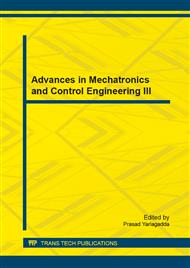[1]
S.M. Barakati, M. Kazerani, and J. D. Aplevich, Maximum tracking control for a wind turbine system including a matrix converter, IEEE Trans. Energy. Convers., vol. 24, no. 99, p.705–713, Sep. (2009).
DOI: 10.1109/tec.2008.2005316
Google Scholar
[2]
R. M. Hilloowala and A. M. Sharaf, A rule-based fuzzy logic controller for a PWM inverter in a stand alone wind energy conversion scheme, IEEE Trans. Ind. Appl., vol. 32, no. 1, p.57–65, Jan. /Feb. (1996).
DOI: 10.1109/28.485813
Google Scholar
[3]
R. Cardenas, R. Pena, M. Perez, J. Clare, G. Asher, and P. Wheeler, Control of a switched reluctance generator for variable-speed wind energy applications, IEEE Trans. Energy Convers., vol. 20, no. 4, p.781–791, Dec. (2005).
DOI: 10.1109/tec.2005.853733
Google Scholar
[4]
Q. Wang and L. Chang, An intelligent maximum power extraction algorithm for inverter-based variable speed wind turbine systems, IEEETrans. Power Electron., vol. 19, no. 5, p.1242–1249, Sep. (2004).
DOI: 10.1109/tpel.2004.833459
Google Scholar
[5]
C. Pan and Y. Juan, A novel sensorless MPPT controller for a high-efficiency microscale wind power generation system, IEEE Trans. Energy Convers., vol. 25, no. 1, p.207–216, Mar. (2010).
DOI: 10.1109/tec.2009.2032604
Google Scholar
[6]
D. A. Torrey, Switched reluctance generators and their control, IEEE Trans. Ind. Electron., vol. 49, no. 1, p.3–14, Feb. (2002).
DOI: 10.1109/41.982243
Google Scholar
[7]
R. Pena, R. Cardenas, J. Proboste, G. Asher, and J. Clare, Sensorless control of doubly-fed induction generators using a rotor-current-based MRAS observer, IEEE Trans. Ind. Electron., vol. 55, no. 1, p.330–339, Jan. (2008).
DOI: 10.1109/tie.2007.896299
Google Scholar
[8]
S. Ichikawa, M. Tomita, S. Doki, and S. Okuma, Sensorless control of permanent-magnet synchronous motors using online parameter identification based on system identification theory, IEEE Trans. Ind. Electron., vol. 53, no. 2, p.363–372, Apr. (2006).
DOI: 10.1109/tie.2006.870875
Google Scholar
[9]
K. Tan and S. Islam, Optimum control strategies in energy conversion of PMSG wind turbine system without mechanical sensors, IEEE Trans. Energy Convers., vol. 19, no. 2 pp.392-399, Jun. (2004).
DOI: 10.1109/tec.2004.827038
Google Scholar
[10]
Z. Chen and E. Spooner, Grid power quality with variable speed wind turbines, IEEE Trans. Energy Convers., vol. 16, no. 2 p.148–154, Jun. (2001).
DOI: 10.1109/60.921466
Google Scholar


